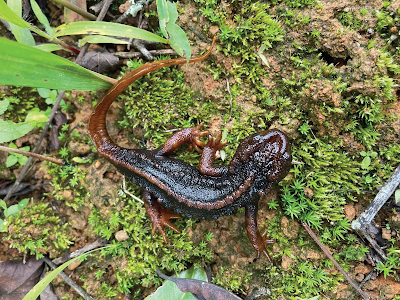Crocodile Newts, Tylototriton spp., range from the eastern Himalayas eastward into central and southern China, and south into Southeast Asia. These Newts are terrestrial outside their breeding season, and have a very narrow range of environmental tolerances, occupying moist subtropical forests at medium-to-high elevations, where the temperature ranges from 15−24.0°C and rainfall is high year-round. Breeding typically occurs during the Monsoon Season.
The most southerly members of the group are found in Thailand, where there are currently considered to be five species, Tylototriton verrucosus, Tylototriton uyenoi, Tylototriton anguliceps, Tylototriton phukhaensis, and Tylototriton panhai. A number of new populations of these Newts have been discovered in recent years, in the Daen Lao, Thanon Thong Chai, and Dawna mountain ranges. All of these have been provisionally assigned to Tylototriton uyenoi, but this is thought unlikely to be correct, as they show some variation and are scattered in mountainous areas in which both lowlands and mountain ridges are likely to present barriers to distribution.
One of these new populations lies within the Umphang Wildlife Sanctuary in Tak Province, and appears to be both physically and genetically distinct from other Tylototriton species. In a paper published in the journal ZooKeys on 19 November 2021, Porrawee Pomchote and Parada Peerachidacho of the Department of Biology at Chulalongkorn University, Axel Hernandez of the Department of Environmental Sciences at the University Pasquale Paoli of Corsica and the Laboratory for Amphibian Systematic and Evolutionary Research at Nanjing Forestry University, Pitak Sapewisut of the Department of Biology at Chiang Mai University, Wichase Khonsue and Panupong Thammachoti again of the Department of Biology at Chulalongkorn University, and Kanto Nishikawa of the graduate schools of Global Environmental Studies and Human and Environmental Studies at Kyoto University, formally describe this Tak Province population as a new species.
The new species description is based upon four male specimens that were collected during a field survey by Porrawee Pomchote and Pitak Sapewisut on 19 June 2021, and subsequently determined to be a new species upon the basis of both morphological and genetic analysis. The new species is named Tylototriton umphangensis, where 'umphangensis' means 'from Umphang'.
Like all Crocodile Newts, Tylototriton umphangensis has granular nodules on its dorsal surface, as we;; as bony ridges on its head and along its spine. It is a medium-sized member of the genus, with a length ranging from 65.6-75.3 mm excluding the tail (Newts can regrow their tails, so the length of a Newt's tail is not considered useful for assessing its size). They have short snouts, bulging quadrate regions, prominent head and spine ridges, and narrow tails. They are dark brown to blackish in colour, with the underside being lighter than the upper.
All four specimens were collected from under leaf litter and among the stems of Arrowroot Plants in a small ephemeral pond in an evergreen forest, during the local rainy season. The pond was 5.2 m long and 2.7 m wide, and 17 cm deep at its deepest. The area lies within the Dawna Mountain Range, which extends from eastern Myanmar into northwestern Thailand, and the species is thought likely to occur elsewhere within this range.
A second population of similar Newts has been reported from an artificial pond near the Mae Klong Khi Forest Ranger Station, but when Pomchote et al. visited this site on the evening of 18 June 2021, they found that Fish had been introduced to this pond, Cattle were roaming freely in the area, and construction work was ongoing, all of which would point to this site being lost to the Newts. Cattle and Human settlements are also encroaching on other natural environments in the area, including national parks, leading Pomchote et al. to conclude that Tylototriton umphangensis should be classified as Endangered under the terms of the International Union for the Conservation of Nature’s Red List of Threatened Species.
See also...
Follow Sciency Thoughts on Facebook.
Follow Sciency Thoughts on Twitter.







